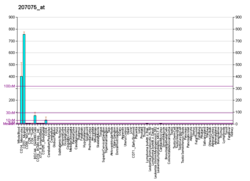| NLRP3 |
|---|
 |
| Visualisation de la protéine Cristallisée NLRP3 |
| Structures disponibles |
|---|
| PDB | Recherche d'orthologue: PDBe RCSB |
|---|
| Identifiants PDB |
|---|
3QF2, 2NAQ |
|
|
| Identifiants |
|---|
| Aliases | NLRP3, NOD-like receptor family, pyrin domain containing 3, CIAS1, NALP3, NACHT, LRR and PYD domains-containing protein 3, CLR1.1, caterpiller-like receptor 1.1 |
|---|
| IDs externes | OMIM: 606416 MGI: 2653833 HomoloGene: 3600 GeneCards: NLRP3 |
|---|
| Position du gène (Homme) |
|---|
 | | Chr. | Chromosome 1 humain[1] |
|---|
| | Locus | 1q44 | Début | 247,416,156 bp[1] |
|---|
| Fin | 247,449,108 bp[1] |
|---|
|
| Position du gène (Souris) |
|---|
 | | Chr. | Chromosome 11 (souris)[2] |
|---|
| | Locus | 11|11 B1.3 | Début | 59,432,394 bp[2] |
|---|
| Fin | 59,457,782 bp[2] |
|---|
|
| Expression génétique |
|---|
| Bgee | | Humain | Souris (orthologue) |
|---|
| Fortement exprimé dans | - monocyte
- granulocyte
- sang
- cellule de la moelle osseuse
- vésicule biliaire
- testicule
- poumon droit
- appendice iléo-cæcal
- upper lobe of left lung
- rate
|
| | Fortement exprimé dans | - granulocyte
- sang
- stroma of bone marrow
- morula
- calvaria
- rate
- glande submandibulaire
- gastrula
- épithélium olfactif
- méninges
|
| | Plus de données d'expression de référence |
|
|---|
| BioGPS | 
 | | Plus de données d'expression de référence |
|
|---|
|
| Gene Ontology |
|---|
| Fonction moléculaire | - sequence-specific DNA binding
- liaison nucléotide
- transcription factor binding
- liaison protéique
- peptidoglycan binding
- liaison ATP
- identical protein binding
| | Composant cellulaire | - cytoplasme
- cytosol
- région extracellulaire
- réticulum endoplasmique
- Inflammasome
- noyau
- NLRP3 inflammasome complex
- Golgi membrane
- appareil de Golgi
- membrane
| | Processus biologique | - réponse de défense
- detection of biotic stimulus
- NLRP3 inflammasome complex assembly
- regulation of transcription, DNA-templated
- negative regulation of acute inflammatory response
- positive regulation of interleukin-5 production
- interleukin-18 production
- processus du système immunitaire
- positive regulation of interleukin-4 production
- transcription, DNA-templated
- positive regulation of cysteine-type endopeptidase activity involved in apoptotic process
- positive regulation of interleukin-13 production
- positive regulation of T-helper 17 cell differentiation
- defense response to virus
- protein complex oligomerization
- positive regulation of T-helper 2 cell differentiation
- regulation of inflammatory response
- interleukin-1 beta production
- positive regulation of type 2 immune response
- réponse inflammatoire
- negative regulation of NF-kappaB transcription factor activity
- activation of cysteine-type endopeptidase activity involved in apoptotic process
- negative regulation of inflammatory response
- cellular response to lipopolysaccharide
- positive regulation of T-helper 2 cell cytokine production
- transduction de signal
- positive regulation of transcription by RNA polymerase II
- apoptose
- système immunitaire inné
- protein deubiquitination
- defense response to Gram-positive bacterium
- positive regulation of NF-kappaB transcription factor activity
- cellular response to peptidoglycan
- negative regulation of NIK/NF-kappaB signaling
| | Sources:Amigo / QuickGO |
|
| Orthologues |
|---|
| Espèces | Homme | Souris |
|---|
| Entrez | | |
|---|
| Ensembl | | |
|---|
| UniProt | | |
|---|
| RefSeq (mRNA) | NM_001079821
NM_001127461
NM_001127462
NM_001243133
NM_004895
|
|---|
NM_183395 |
| |
|---|
| RefSeq (protéine) | NP_001073289
NP_001120933
NP_001120934
NP_001230062
NP_004886
|
|---|
NP_899632 |
| |
|---|
| Localisation (UCSC) | Chr 1: 247.42 – 247.45 Mb | Chr 11: 59.43 – 59.46 Mb |
|---|
| Publication PubMed | [3] | [4] |
|---|
|
| Wikidata |
| Voir/Editer Humain | Voir/Editer Souris |
|
La NLRP3 (« NOD-like receptor family, pyrin domain containing 3 » ou CIAS1) est un complexe de type inflammasome. Son gène est le NLRP3 situé sur le chromosome 1 humain. Ses autres noms sont le NALP3 (« NACHT, LRR and PYD domains-containing protein 3 ») ou le CLR1.1 (« caterpiller-like receptor 1.1 »). On le nommait anciennement cryopyrine d'où le terme pathologique qui est resté : cryopyrinopathies.
Il interagit avec le CARD8[5].
Il régule la caspase 1 qui permet l'activation de l'interleukine 1 bêta[6].
En médecine
La mutation du gène NLRP3 provoque des maladies auto-inflammatoires appelées cryopyrinopathies qui sont, par ordre croissant de gravité :
- L'urticaire familiale au froid
- Le syndrome de Muckle Wells
- Le CINCA ou NOMID
Ces mutations entraînent une activation constitutive de l'inflamasome NLRP3, et donc une suractivation de la cytokine pro inflammatoire IL1 béta. La plupart des mutations surviennent dans le domaine Natch du complexe.
Notes et références
- ↑ a b et c GRCh38: Ensembl release 89: ENSG00000162711 - Ensembl, May 2017
- ↑ a b et c GRCm38: Ensembl release 89: ENSMUSG00000032691 - Ensembl, May 2017
- ↑ « Publications PubMed pour l'Homme », sur National Center for Biotechnology Information, U.S. National Library of Medicine
- ↑ « Publications PubMed pour la Souris », sur National Center for Biotechnology Information, U.S. National Library of Medicine
- ↑ Ito S, Hara Y, Kubota T, CARD8 is a negative regulator for NLRP3 inflammasome, but mutant NLRP3 in cryopyrin-associated periodic syndromes escapes the restriction, Arthritis Res Ther, 2014;16:R52
- ↑ Haneklaus M, O’Neill LA, Coll RC, Modulatory mechanisms controlling the NLRP3 inflammasome in inflammation: recent developments, Curr Opin Immunol, 2013;25:40–45
 Portail de la biologie cellulaire et moléculaire
Portail de la biologie cellulaire et moléculaire  Portail de la médecine
Portail de la médecine

 Portail de la biologie cellulaire et moléculaire
Portail de la biologie cellulaire et moléculaire  Portail de la médecine
Portail de la médecine 


















